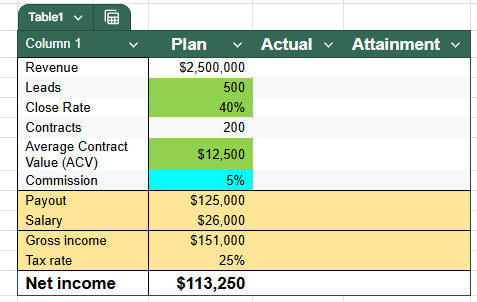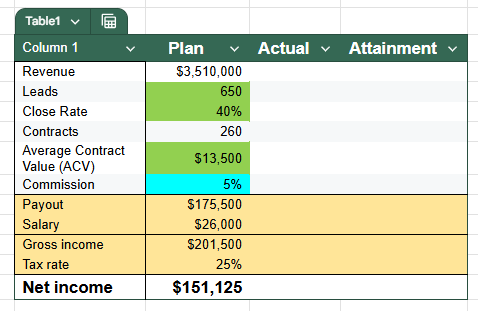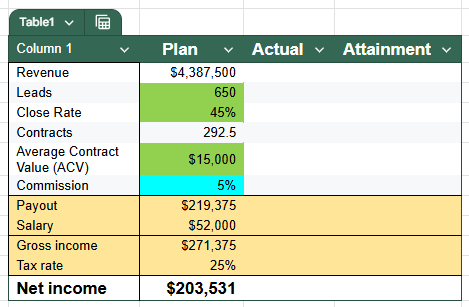How to Create a Six-Figure Income Plan for Roofing Sales Reps: Your Step-by-Step Playbook

“You’re just one roof away from never worrying about money again.”
Roofing sales has zero income ceiling — but most reps still get stuck around the same number every year.
Why?
They wing it. No targets. No systems. No real path.
If you’re tired of that rollercoaster and ready to hit six figures (and beyond), you’re in the right place. I’ve worked alongside enough roofers, and have learned through my own experience, to know the patterns that build wealth — and the habits that kill it.
This guide walks you through a practical, repeatable income plan built for roofing sales reps.
Whether you’re new, plateaued, or pushing into multi-six-figures, this plan will help you:
- Identify exactly how many roofs you need to close
- Build an action-based daily plan
- Track your income like a business owner, not a door knocker
What You’ll Learn:
- Why six figures is easier than you think (with the right math)
- How to reverse-engineer your income target
- Tools to stay consistent when deals slow down
- How to scale from $100K to $250K+ in roofing sales
For getting crystal clear on how to set S.M.A.R.T. goals, check out this article
Why Most Roofers Fall Short of Six Figures
A majority of people start believing the biggest lie in roofing sales: that you need storm damage to make real money. Meanwhile, they're riding this brutal feast-or-famine cycle, celebrating $15K months followed by $3K disasters.
The problem isn't the weather - it's the mindset.
Most reps treat roofing like a lottery ticket instead of a business. They chase storms, wait for perfect leads, and then wonder why their income looks like a roller coaster.
As a newbie business analyst for a top roofing company I realized something: the top producers in my company were hitting six figures in non-storm markets too.
The difference? They had a roadmap. While most are hoping for hail damage, they were systematically working referral networks, building relationships with insurance adjusters, and following up with precision.
They treated every month like it mattered, not just the lucky ones.
Here's what really opened my eyes when I made the jump to the sales side: I tracked my activity for three months and discovered I was confusing motion with progress.
I'd spend entire days "working" but only generate two qualified leads. Meanwhile, the six-figure guys were laser-focused on revenue-generating activities.
The breakthrough came when I stopped waiting for perfect conditions and started creating consistent systems.
No storms?
Fine - I'll work retail sales, repair jobs, and focus on building value.
Light lead flow?
Time to activate my referral network and past customer database.
Six figures happens when you control what you can control, every single day.
Reverse-Engineer Your Six-Figure Goal
The first time I hit $100K, it felt like pure luck. The second time at $150K, I started seeing patterns. By the time I reached $200K last year, I realized it was all about working backwards from the number.
Here's the math that changed everything for me (with a $500/wk salary and 5% commission rate):
$100K Goal: After taxes and expenses, I needed about $125K gross. With my average commission at $625 per job, that meant closing 200 jobs for the year. Broken down: 17 jobs per month, or roughly 4 jobs sold each week.

$150K Goal: This required 260 jobs annually at my improved $675 average commission. That's 22 jobs monthly - still very achievable when you see it like that.

$200K Goal: Here's where it got interesting. My salary doubled from taking on a leadership role. I still needed 293 jobs, but I also had to increase my average deal size to $15,000 to get a $750 commission. This meant focusing on higher-end neighborhoods and adding more services like higher grade materials, gutters, and ventilation options to each proposal.

The daily breakdown is what makes it real. For $150K, I needed to run about 54 estimates per month (with my 40% close rate). That's thirteen estimates per week. Suddenly, that massive income goal becomes "book 13 solid estimates every seven days."
Weekly targets keep me honest:
3 new leads, 2 follow-up calls, 1 estimate appointment. Hit those numbers consistently, and six figures becomes inevitable, not lucky.
The magic happens when you realize these aren't impossible numbers - they're just consistent behaviors repeated over time.
Create a Daily Action Plan That Wins
My first year, I was knocking doors a week just trying to survive. Now that my company provides leads, I've had to completely reimagine what productive daily action looks like. The income targets stayed the same, but the behaviors shifted dramatically.
Here's my current daily breakdown for $150K:
- 2 follow-up calls to warm prospects
- 1 new lead qualification call
- 3 referral requests from recent customers
- 3 estimate appointments (either running it or booking it)
The 2-hour rule saved my consistency. Even on crazy days, I commit to two hours of revenue-generating activity before anything else.
I call this SACRED TIME:
No checking email, no paperwork, no "quick" tasks. Just income-producing behaviors first. Let people know about sacred time as well so they don't interrupt your activity.
Scheduling beats reacting every time. Block 8-10 AM for prospecting calls and automated emails when homeowners are most likely to answer. Follow-ups happen 2-4 PM when people are thinking about getting home and tackling projects. Try running estimates 4-7 PM when both spouses are typically available.
During storm season, time-blocking becomes critical. When leads are flooding in, it's tempting to chase every shiny object.
But stick to a schedule: mornings for new leads, afternoons for follow-ups, evenings for estimates.
That structure keeps prevents getting overwhelmed and missing opportunities.
The key is making these behaviors non-negotiable. Income goals are just dreams until you translate them into daily actions you can control.
Track the Right Sales Metrics
Organization has always been my superpower, and nowhere does that pay off more than in tracking the right numbers. I've built spreadsheets that predict my income three months out - and they're scary accurate.
Here's what I track religiously:
Close rate: Mine sits at 45%, which means I need roughly 2.2 estimates to close one job. This number tells me everything about my pipeline health.
Average deal size: Currently $17,200, but I track this monthly because it fluctuates with seasons and neighborhoods. Summer repair jobs average $1,800 while storm work can hit $12,000 - $20,000+.
Leads per week: My company provides about 10-12 qualified leads weekly. I track conversion from lead-to-estimate (68%) and estimate-to-close (45%).
These numbers become my personal coach.
When my close rate dropped to 35% in July, I immediately knew something was off. Turned out I was rushing presentations during busy season. Fixed that, and we were back to 41% by August.
My monthly review process is simple:
pull the numbers, spot the trends, adjust the tactics.
If average deal size is dropping, I focus on upselling. If leads are light, I activate referral campaigns.
The spreadsheet does all the heavy lifting - forecasts my pipeline, calculates commission projections, even tells me exactly how many estimates I need to book to stay on target.
Download our Sales Forecaster Spreadsheet and start predicting your income like a pro.
Numbers don't lie, and they'll show you exactly where to focus your energy.
Boost Your Close Rate (Without Being Pushy)
Our sales team spends three hours every single week polishing our presentation and practicing objection handling. Sounds like overkill until you realize that improving my close rate from 35% to 42% added $23,000 to my annual income without working more hours.
Understanding roofing psychology changed everything for me.
Homeowners aren't just buying shingles - they're buying peace of mind and protection for their biggest investment. When I shifted from talking features to addressing fears my conversions jumped immediately.
The pre-close work is where deals get won or lost. It could be sending educational videos before appointments, sharing testimonials from neighbors in similar situations, or always bringing photos of completed projects in their area.
By the time you're sitting at their kitchen table, they already see you as the expert.
Attending the Top Rep Sales Summit last year was a game-changer. I learned this soft follow-up technique that feels helpful, not pushy: "I'll check back in 48 hours with answers to the questions you had about the warranty coverage."
Boom - permission to follow up without being aggressive.
Here's the truth about confidence: it's contagious.
When you know your stuff inside and out, homeowners feel it. They're not buying from someone who's unsure - they're buying from someone who solves problems with certainty.
Practice makes permanent. Every week, role-play tough objections and refine your presentations. That consistent improvement shows up directly in commission checks.
Increase Deal Size and Upsell Smart
My average deal jumped from $11,800 to $14,200 once I stopped thinking of upsells as "pushing products" and started seeing them as solving problems. Solar attic fans and gutters aren't add-ons - they're logical solutions that protect the homeowner's largest investment.
The key is timing and positioning. I never lead with upgrades. Instead, I let them naturally flow from the conversation.
When homeowners mention high energy bills, solar attic fans become an obvious recommendation.
When they ask about future maintenance or foundation issues, gutters make perfect sense.
Here's my ethical upsell framework: I only recommend what I'd put on my own house.
Solar attic fans pay for themselves in energy savings, and quality gutters prevent foundation issues down the road.
In order to be convincing, you've got to be convinced.
When you believe in the value, it shows in your presentation.
Our $200 referral program has become my secret weapon for closing deals and building relationships. I present it as a win-win: "When your neighbors see this beautiful roof, they'll ask questions. Here's how we can make that conversation profitable for you."
It adds value without being pushy.
Pro Tip: Give them something of value NOW, not just a future promise. It could be a simple $10 Amazon gift card for even considering introducing you to your neighbor who's got some missing shingles.
The profit margin difference is huge. Basic shingle jobs might net 18-22%, but when I add solar fans and gutters, margins jump to 28-34%. That's where the real money lives - not just in closing more deals, but in maximizing each opportunity.
Smart upselling serves the customer first, your commission second. Get that order right, and both win.
Stack Wins: Momentum, Motivation, Mastery
Momentum is everything in roofing sales. When I'm on a hot streak, everything feels easier - presentations flow better, objections melt away, and even tough customers seem more agreeable.
The trick is learning how to create that momentum artificially when it's not happening naturally.
I celebrate every win, but I've learned to celebrate smart.
Closed a big job?
Great - I take the family out for dinner, then immediately book two more estimates for the following week. The celebration fuels the next push instead of becoming an excuse to coast.
Dry spells test your character. When I hit three "no's" in a row, I fall back on fundamentals: review my presentation videos, practice objection handling, and focus on activities I can control.
Sometimes the best thing you can do is sharpen your axe while waiting for the next tree.
My weekly reset ritual happens every Sunday night. I review the previous week's numbers, celebrate the wins (even small ones), identify what needs improvement, and set three specific goals for the coming week. It's like hitting a refresh button on my mindset.
While other reps burn out chasing perfection, focus on progression.
Last month was better than the month before? That's a win. Close rate improved by 2%? Another win. These small victories stack up and create unstoppable momentum.
The secret is treating each week like a new season - fresh opportunities, clean slate, unlimited potential.
You don’t need more talent or a golden territory to hit six figures in roofing sales.
You need a clear income plan, backed by daily action and real-time feedback. When you treat roofing like a business, not a hustle, the money becomes predictable.
Start today. Pull out a calculator. Set your goal. Break it down. Commit to the process — and watch the commission checks stack up.